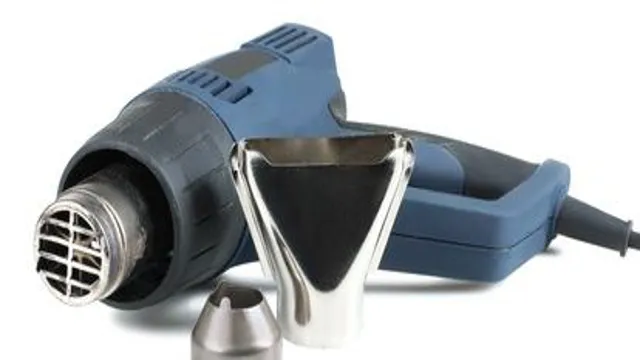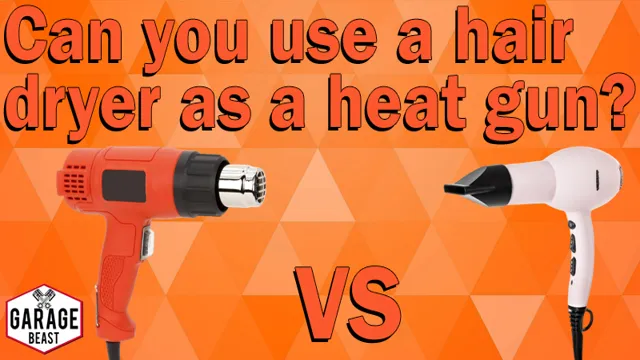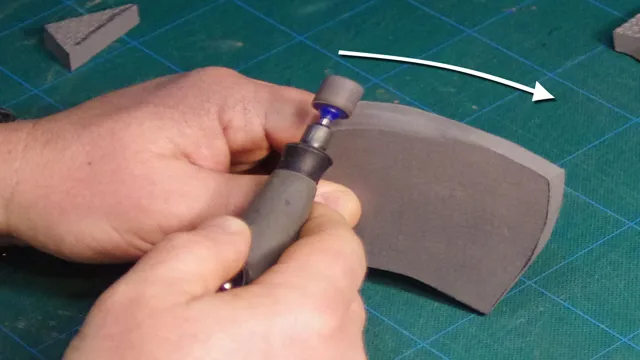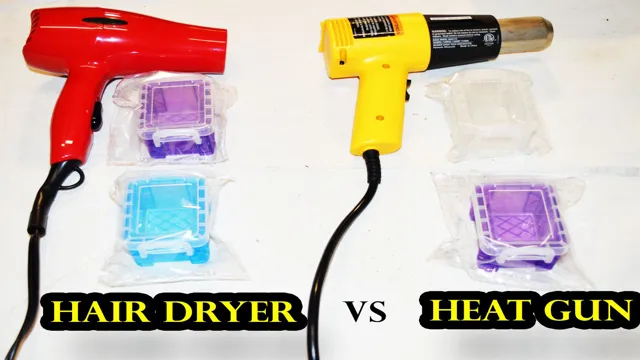What is a Heat Gun Used For? Discover Top Applications and Benefits
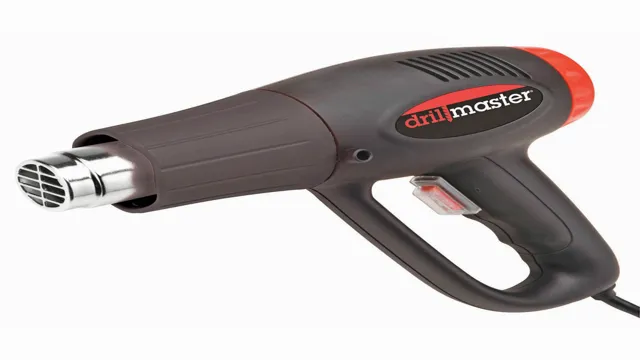
If you’re into DIY projects, then you may have heard of a heat gun. But what exactly is it and what can it be used for? Think of a heat gun as a handheld device that produces blasts of hot air. This tool has found its way into several industries, including automotive, construction, and crafting.
From removing paint to thawing frozen pipes, a heat gun is a versatile tool that can make your life a whole lot easier. In this blog post, we’ll delve deeper into what a heat gun is and the various ways you can use it to make your DIY projects a success.
Definition of a Heat Gun
A heat gun is a powerful tool utilized to generate hot air at varying temperatures and intensity levels. These guns are favored by professionals across various industries, including construction, automotive, and manufacturing. They can be used for a wide range of tasks, such as soldering, desoldering, welding, drying paint, thawing frozen pipes, defrosting freezers, and even cooking.
Heat guns direct hot air on a particular area, speeding up processes, and solving certain problems faster than other conventional methods. The temperature output of a heat gun can range from 100 to 1,000 degrees Fahrenheit, depending on the model and intended use. They come with a variety of nozzles, enabling users to direct the hot air with precision, making them incredibly versatile.
Overall, heat guns offer an effective, efficient, and precise heat source for a range of commercial and domestic tasks.
Explanation of a Heat Gun
A heat gun is a powerful tool that can be used for a variety of tasks, from heating up stubborn nuts and bolts to shrink-wrapping packages. Simply put, a heat gun is a handheld device that uses electric power to produce hot air, usually around 1000 degrees Fahrenheit. This intense heat can be concentrated onto a specific area, allowing the user to apply heat with greater precision.
This makes heat guns an important tool for DIY enthusiasts, plumbers, electricians, and anyone who needs to manipulate materials with heat. Heat guns come in various sizes and shapes, but the most common design is a pistol grip with a nozzle that directs the hot air. Safety is important when using a heat gun, as prolonged exposure to the intense heat can cause burns or other injuries.
To help prevent accidents, it’s important to use the heat gun according to the manufacturer’s instructions and to always wear protective gear. Overall, a heat gun is a versatile and useful tool for anyone who needs to apply heat in a controlled and concentrated way.
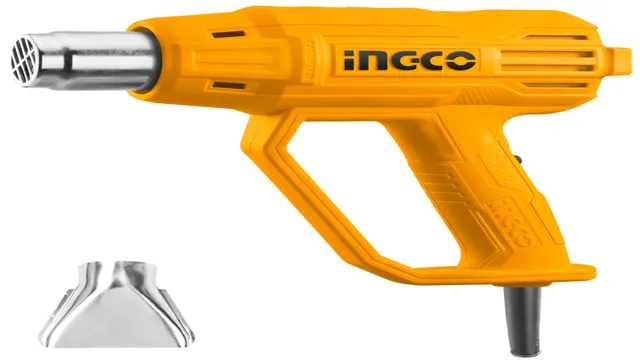
Heating Applications
If you’re wondering what a heat gun is used for, there are a wide variety of heating applications ranging from simple household tasks to professional use. One common use of a heat gun is for DIY projects such as stripping paint or thawing frozen pipes. A heat gun can also be used for shrink-wrapping and bending plastic materials such as PVC pipes or sheet metal.
Additionally, heat guns are frequently used in the automotive industry for creating a sealant or removing decals and vinyl from vehicles. Some professionals also use heat guns for welding or molding certain materials. While heat guns may seem simple, they are versatile and powerful tools that should be used with caution and proper safety measures.
All in all, whether you’re a DIY enthusiast or a professional, a heat gun is a must-have tool in your arsenal.
Paint Stripping and Removal
When it comes to paint stripping and removal, heating applications are a popular choice for many reasons. Heat guns and torches can quickly and efficiently remove paint from various surfaces, including wood, metal, and brick. The heat softens the paint, allowing for easy removal with a scraper or brush.
Plus, heating applications are often more environmentally friendly than chemical strippers, which can release harmful fumes. However, it’s important to use caution when using heat to strip paint, as it can be a fire hazard if not done properly. It’s essential to wear protective gear, including goggles and gloves, and to work in a well-ventilated area.
With these precautions in mind, heating applications can be an effective and safe way to remove paint from surfaces.
Welding and Soldering
When it comes to welding and soldering, heating applications are crucial for achieving successful results. Heating is necessary to melt and join two pieces of metal together. In welding, a high-heat source such as a welding torch is used to fuse the two metal pieces.
This can be done with gas, electricity, or even lasers. Soldering, on the other hand, uses a lower-heat source such as a soldering iron to melt a metal alloy that is then used to join the two metal pieces. Both welding and soldering require precision and control to avoid overheating and damaging the metal pieces.
It’s important to choose the right heating method for the job at hand and to ensure that the metal pieces are properly prepared and cleaned before beginning the process. With the proper heating application, welding and soldering can create strong, durable bonds that will stand the test of time.
Shrinking Tubing and Film
Shrinking tubing and film are essential components in various industrial applications. They are used to protect and insulate wires, cables, and other components, as well as packaging products and bundling items together. When it comes to heating applications, shrinking tubing and film play a crucial role in ensuring a secure and snug fit over the desired object.
The process of heating tubing and film can be accomplished using various methods such as hot air bending, infrared radiation, and convection heating. One of the most popular methods is heat shrinking tubing and film using a heat gun. The heat gun produces hot air that is directed towards the tubing or film, causing it to shrink and conform to the object’s shape.
This method is relatively simple and straightforward, making it a popular choice in many industries. However, when using shrinking tubing and film, it is crucial to choose the right material and ensure that it can withstand the heat generated during heating. Additionally, attention must be paid to the required diameter and the amount of heat applied to avoid damaging the tubing or film.
With proper care and attention, heat shrinking of tubing and film can be a reliable and effective solution to many industrial needs.
DIY and Home Improvement
If you’re planning on tackling a DIY or home improvement project, a heat gun can be one of your most valuable tools. Heat guns are versatile devices that can be used for a variety of tasks, from removing paint to thawing frozen pipes. With a heat gun, you can create a concentrated stream of hot air that can soften and melt various materials.
For example, a heat gun can be used to strip old paint from surfaces, bending plastic pipes, and sealing shrink wrap. The high-temperature stream of air that a heat gun produces can also be used to speed up the drying time of paint, adhesives or other coatings applied to surfaces. Additionally, heat guns are an effective way of removing stickers or decals from surfaces.
Overall, a heat gun is a useful tool to have in your arsenal for a variety of DIY and home improvement projects.
Thawing Frozen Pipes
Thawing frozen pipes can be a daunting task for any homeowner, but with a little DIY effort and a few simple steps, you can get your pipes flowing smoothly again. First, turn off the water supply to prevent any further damage. Then, locate the frozen area of the pipe by feeling for any cold spots or bulging areas.
If you’re having trouble finding the blocked section, you can use a hairdryer or heat lamp to warm up the pipe until the problem area is identified. Next, you can try thawing the pipe using a space heater or heat tape. Be sure to use these tools safely and closely monitor their use to prevent any accidents.
If all else fails, you may need to call in a professional plumber. Remember, prevention is always the best remedy – make sure your pipes are properly insulated to prevent future freezing. By taking these simple steps, you can avoid the headache of dealing with burst water pipes and keep your home comfortable and safe.
Drying Wet Surfaces and Materials
Drying wet surfaces and materials can be a real challenge, especially when it comes to home improvement and DIY projects. Whether you’re dealing with a spilled drink on a carpet or a flooded basement, the key is to act fast and use the right techniques. One of the simplest ways to dry a wet surface is to use a clean, absorbent cloth or towel to soak up as much moisture as possible.
For larger areas or more persistent moisture, you may need to use a fan, dehumidifier or even a wet vac. Another option is to use natural drying agents such as baking soda or kitty litter, which can absorb moisture and leave surfaces clean and dry. Whatever method you choose, be sure to check the materials and surfaces involved to avoid damage or further problems down the line.
With a little patience and some elbow grease, you can be sure that your wet surfaces will be dry and ready for whatever comes next!
Precautions and Safety Measures
A heat gun is a versatile tool that can be used for a variety of tasks, such as removing old paint or varnish, thawing frozen pipes, drying wet surfaces, shrinking tubing and packaging, and even cooking. However, it’s important to take some precautions and safety measures when using a heat gun. First, always wear heat-resistant gloves and eye protection to avoid burns and eye injury.
Also, keep the heat gun at a safe distance from flammable materials and never leave it unattended while it’s on. Always make sure to turn it off and unplug it when you’re finished using it. Additionally, you should be aware of the surface temperature before touching it with your bare hands, and avoid directing the heat towards your body or other people.
By taking these simple precautions, you can safely and effectively use a heat gun for various applications.
Tips for Safe Heat Gun Use
Heat gun use can be dangerous if proper precautions and safety measures are not taken. Before using a heat gun, it’s essential to read its manual and follow the manufacturer’s guidelines. Always wear protective gear like heat-resistant gloves, goggles, and a mask to protect your eyes and lungs from fumes.
When using a heat gun, never point it at yourself or others, and make sure to keep it away from flammable objects and materials. Also, avoid touching the nozzle with your skin or wearing loose clothing that can get caught. Remember to unplug the heat gun after use, and let it cool down before storing it away.
By following these simple safety tips, you can effectively use a heat gun without endangering yourself or others around you.
Conclusion
In the simplest terms, a heat gun is like a hair dryer on steroids. But unlike your trusty hair styling tool, this bad boy isn’t just for making you look fabulous – it’s a versatile piece of equipment that’s used for everything from stripping paint to thawing frozen pipes. In other words, if you need to heat stuff up, a heat gun is your go-to gadget.
So yes, it’s a bit of a wonder tool really – perfect for any DIY enthusiast or just someone who wants to feel like a superhero wielding a powerful instrument of heat and destruction!”
FAQs
What is a heat gun used for?
A heat gun is mainly used for tasks that involve heating, drying, or stripping.
How do you use a heat gun?
Firstly, read the instructions for ensuring safety. Secondly, plug the heat gun, choose a temperature and speed setting, then point it towards the object you wish to heat.
What are the advantages of using a heat gun?
Heat guns are designed to offer high-temperature functionality with precision, flexibility, and safety.
Are heat guns safe to use?
Heat guns are safe to use as long as you follow the instructions, wear safety gear, and take precautions.
What materials can you use a heat gun on?
Heat guns can be used on a variety of materials, including shrink wrap, plastic, paint, wood, and metal.
Can a heat gun be used for soldering?
Yes, a heat gun can be utilized for soldering, but it may not be as precise as other tools designed specifically for soldering.
What is the best heat gun for a DIY project?
The best heat gun for DIY projects depends on the type of materials you’re working on, the intensity of heat required, and the intended use. It is best to research the options available within the budget.

